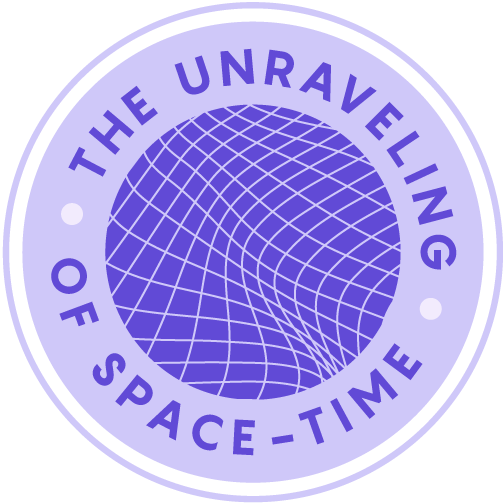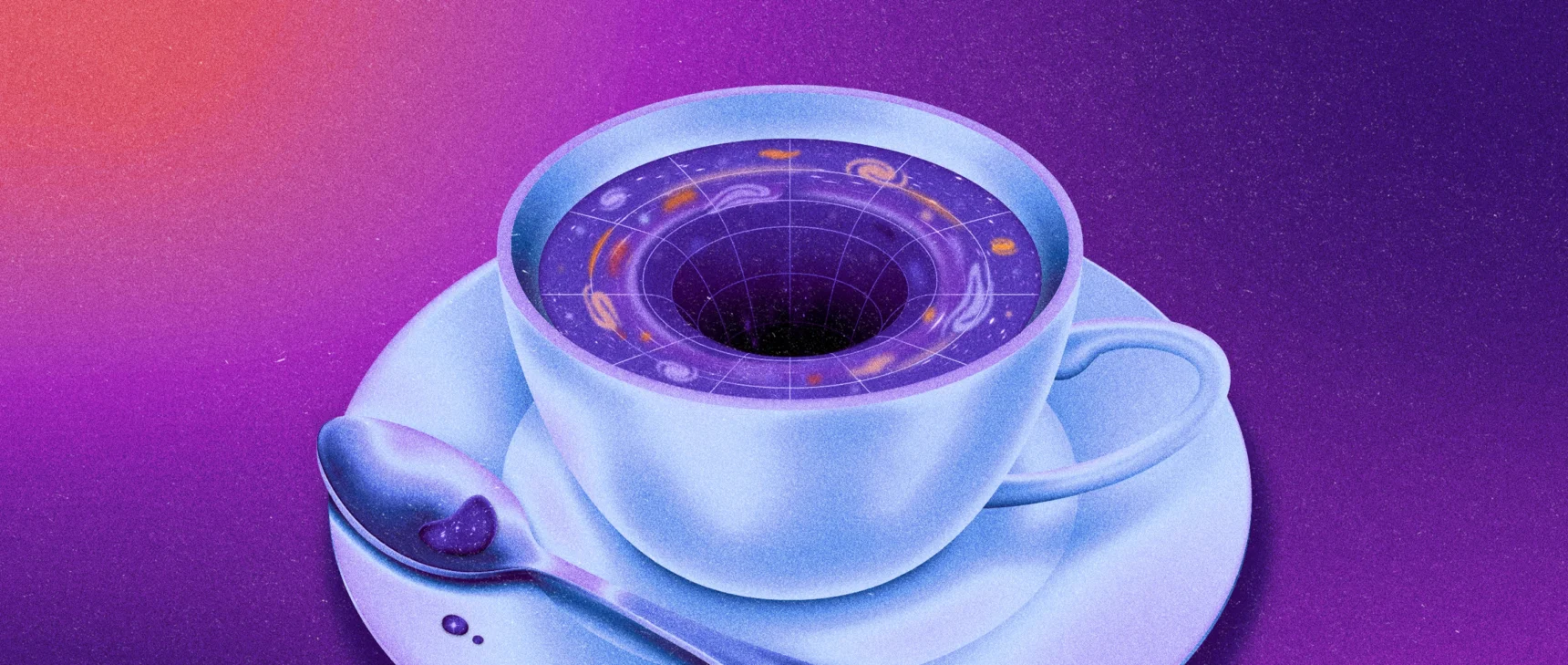If the Universe Is a Hologram, This Long-Forgotten Math Could Decode It
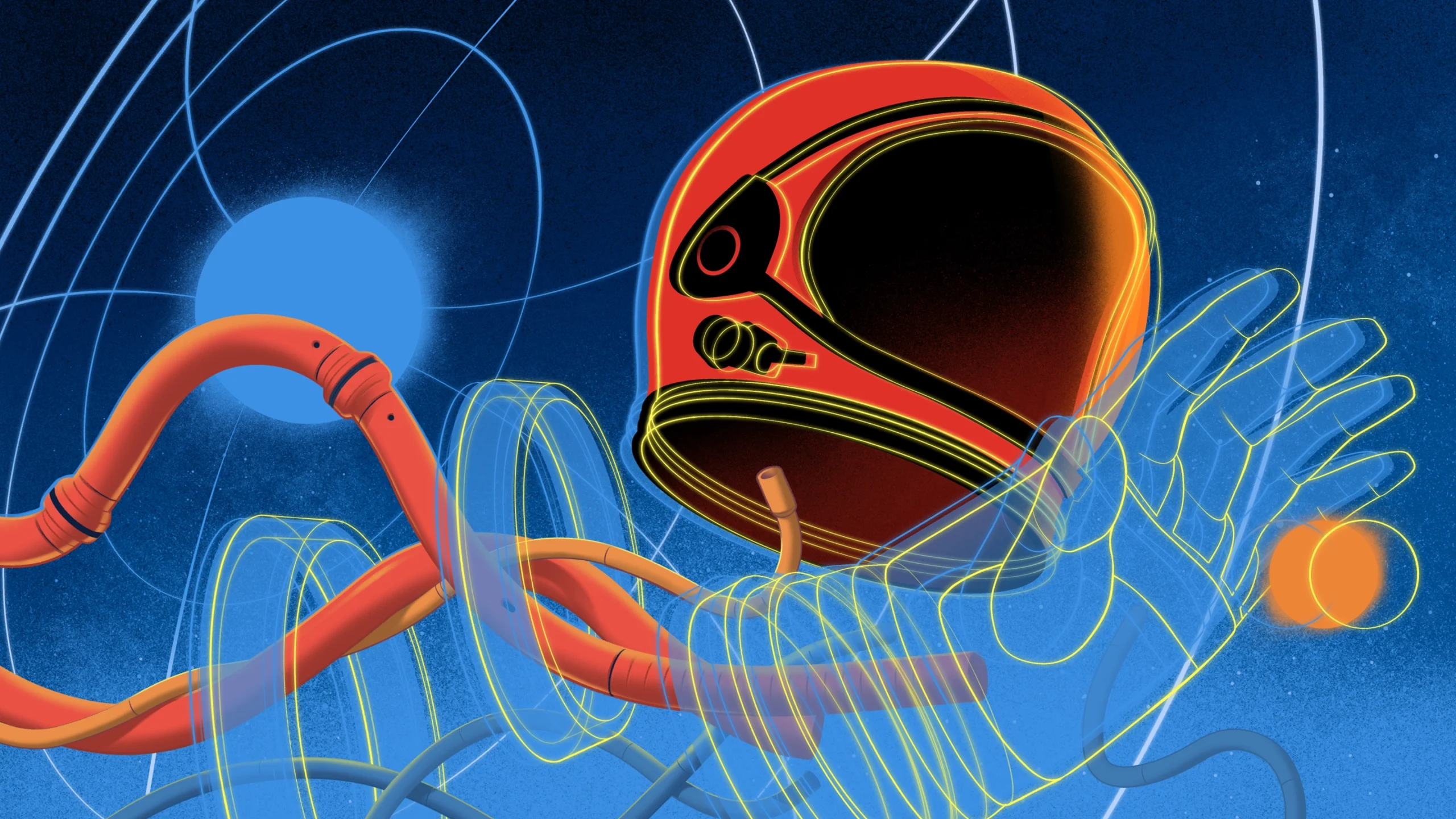
Motivated by the mysteries of black holes, theorists are advancing their ability to describe space-time as a hologram.
Señor Salme for Quanta Magazine
Introduction
John von Neumann came about as close as humanly possible to embodying the Platonic ideal of a genius. Conversant in ancient Greek by age 6, the Hungarian made significant mathematical advances in his teens. Then, as an adult, he invented game theory and helped design the atomic bomb and the modern computer.
Along the way, as a young man in 1932, von Neumann rewrote the rules of quantum mechanics, formulating the strange new theory of particles and their fluctuating, probabilistic behavior in the mathematical language used today. Then he went further. He developed a framework known as “operator algebras” to describe quantum systems in a more powerful but more abstract way. Unlike his earlier work on quantum theory, this framework was hard to understand and did not catch on widely in theoretical physics. It was literally a century ahead of its time.
Over the past few years, however, more physicists have been dusting off von Neumann’s ideas. His operator algebras are now helping them see their way around the most mysterious quantum system yet: the substructure of space and time.
Even before von Neumann did his work, Albert Einstein’s theories of relativity merged space and time into a four-dimensional fabric known as “space-time.” Einstein showed that the force of gravity is generated by curves in this fabric. But physicists know that the fabric can’t be the whole story. Dying stars puncture it, creating intensely warped regions called black holes where the equations of general relativity break down. And even in calmer parts of space-time, when you zoom in to the smallest scales, quantum fluctuations seem to shred it apart.
Many theoretical physicists therefore believe that space-time will go the way of water, metals, and so many other substances before it; what seems like a smooth and simple medium will turn out to be made of a complicated collection of primitive quantum entities. For decades, theorists have wondered about those entities and how the space-time fabric emerges from them.
These physicists are now gaining a deeper understanding of space-time’s quantum weave. They’re developing new ways of predicting what happens in extreme regions where space-time as we know it unravels, as well as identifying the conditions that normally allow it to hang together. At the heart of the progress has been von Neumann’s abstruse research.
“People have been kind of scared of it,” said Antony Speranza, a physicist at the University of Amsterdam. But “it does seem to give you these algebraic tools for seeing that a space-time is emerging.”

The Emergence of Emergence
In the spring I took the train to Princeton, New Jersey, and walked to the pastoral campus of the Institute for Advanced Study. This was where von Neumann developed the math of operator algebras, and where Albert Einstein lived out his days, after both immigrated to the United States and joined the institute’s first generation of professors. It remains a major hub of fundamental research. My first stop was the chalkboard-lined office of Juan Maldacena, one of the most respected theorists working today.
In 1997, the Argentinian physicist caught the first glimpse of the most famous example of how space-time can emerge — an enigmatic relationship known as the AdS/CFT correspondence. “It gives you an explicit model of emergent space-time,” Maldacena told me.
The correspondence amounts to a striking quantum conspiracy.
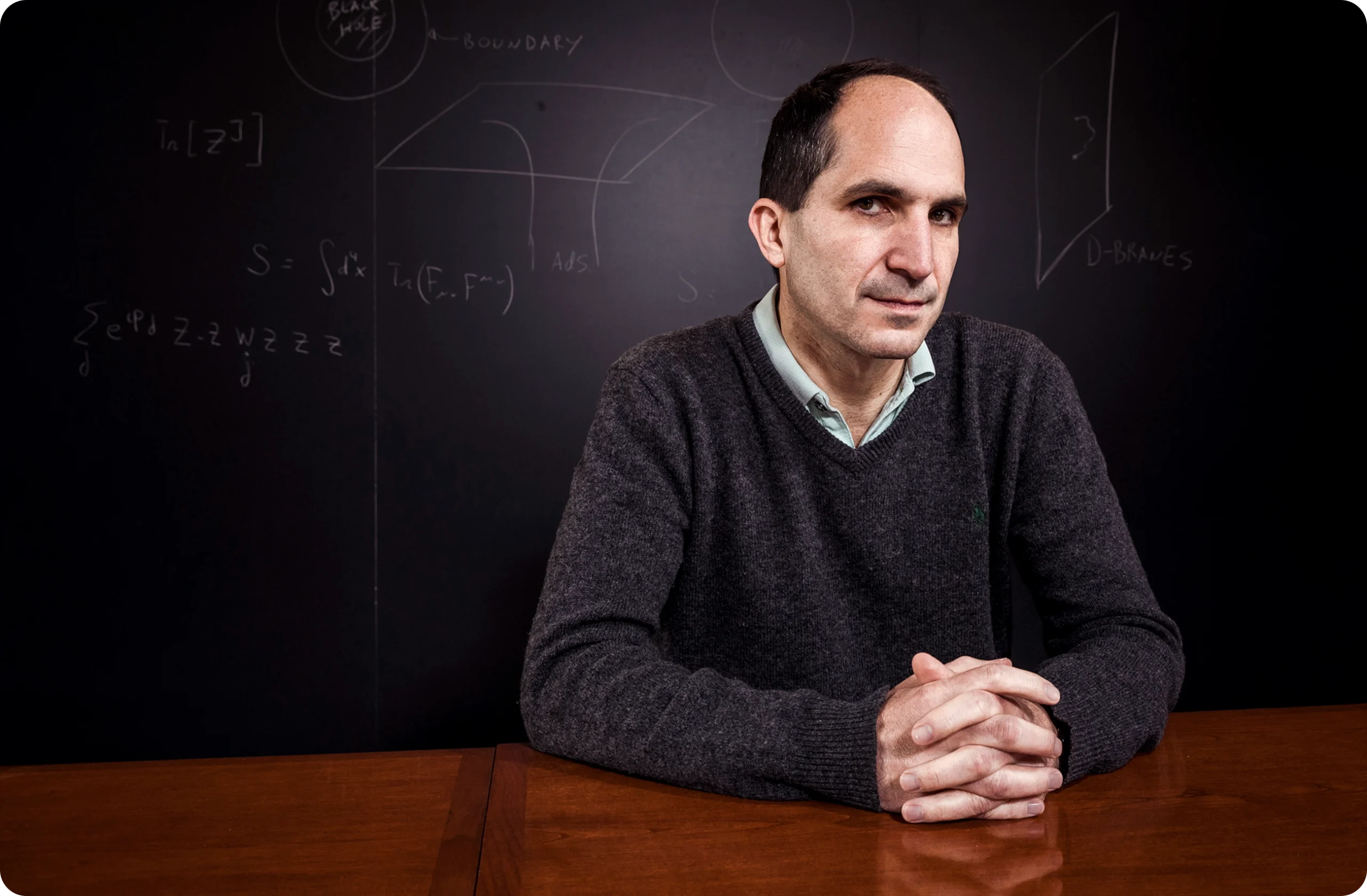
Juan Maldacena, a physicist at the Institute for Advanced Study, discovered a way of recasting a black hole in an exotic space-time as a collection of quantum ripples.
Sasha Maslov for Quanta Magazine
To get a sense of how it works, imagine you have a two-dimensional sheet of metal wrapped into a sphere, like a hollow aluminum ball (it remains 2D in the sense that you can locate any point on it with a longitude and a latitude). The sheet hosts quantum particles, which can be thought of as tiny ripples in media known as quantum fields. These fields and their ripples obey complicated but well-tested mathematical rules, known as quantum field theory. In this case, the ripples follow a symmetric theory known as a conformal field theory or CFT.
The big surprise, which Maldacena and others have now explored in thousands of papers, is that this two-dimensional surface is mathematically equivalent, or “dual,” to the three-dimensional volume it encloses, called the bulk. The duality gives rise to an entire toy universe. Certain collections of ripples on the 2D boundary might represent a 3D star in the bulk, for instance, and others a bulk planet.
The bulk universe differs from ours in that its space has an intrinsically negative energy, making it “anti-de Sitter” or AdS space. But other than that, it looks a lot like our home; it’s a malleable space-time fabric whose curves produce gravity. The AdS/CFT correspondence opens up the tantalizing possibility that physicists could do an end run around physics they don’t understand (quantum gravity in the bulk) by using only physics they do understand (quantum field theory).
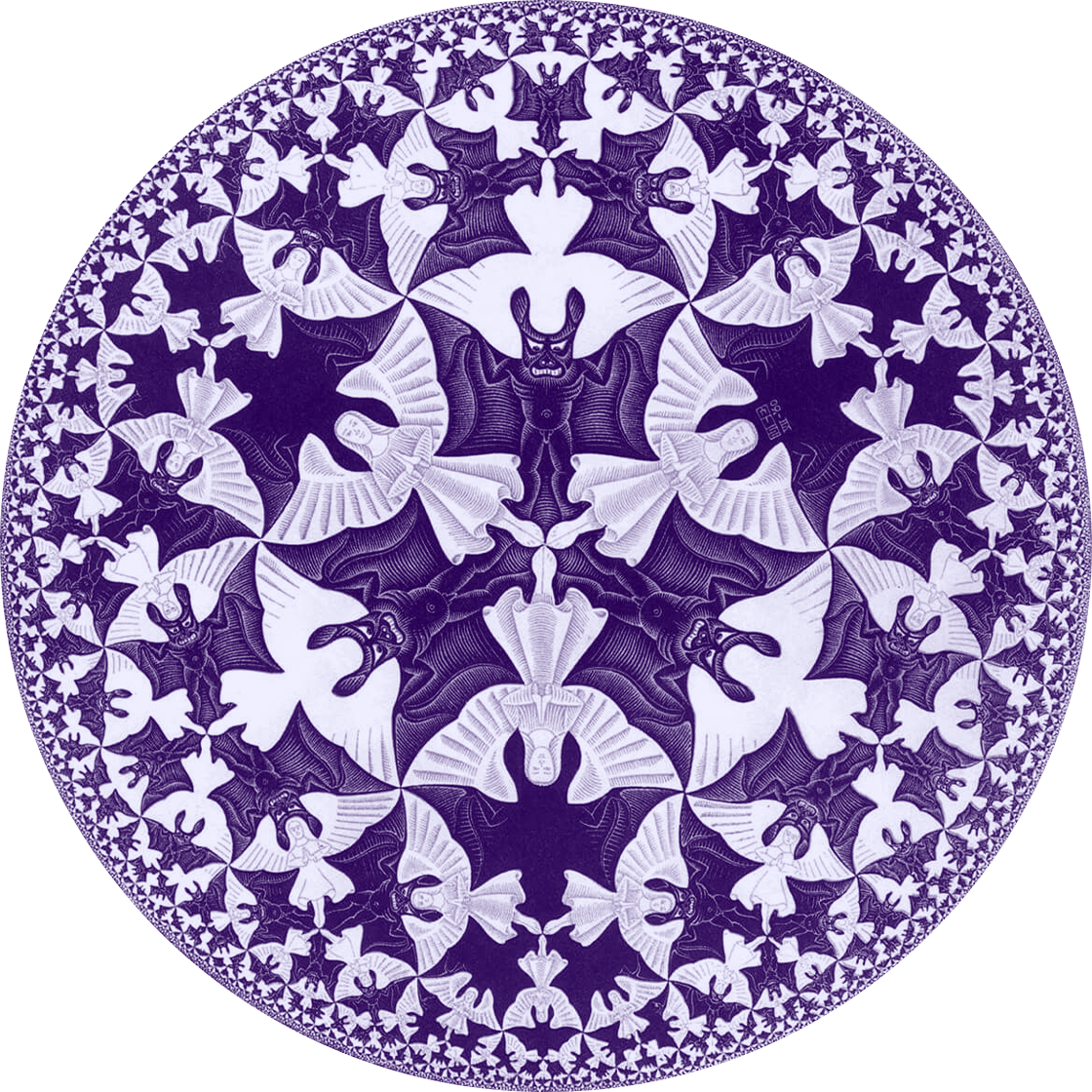
M.C. Escher’s Circle Limit IV woodcut depicts a geometry in which an infinite expanse of angels and demons fits into a bounded region. Anti-de Sitter space has the same geometry.
M.C. Escher
“It’s saying gravity is not something separate from regular quantum theory,” said Josephine Suh, a physicist at the Korea Advanced Institute of Science and Technology. “It’s saying that gravity is just a different description of a quantum theory.”
Maldacena’s “holographic duality” linked CFTs on a lower-dimensional boundary with AdS space-time in the bulk. But his work did not specify exactly which patterns of quantum ripples on the boundary would represent, say, a star in the bulk, and which would pinch space-time into a black hole. So over the following decades, researchers developed increasingly sophisticated ways to do so. These methods, which involve powerful mathematics called tensor networks and quantum error-correcting codes, amount to, very roughly, tapping out patterns of ripples in the boundary sphere that correspond to measurements at specific locations in the bulk.
No one knows if the space-time fabric of our real universe is holographic. One convenient feature of negative-energy AdS space is that it has a spatial boundary for those quantum ripples to live on; our universe does not. But the AdS/CFT correspondence provides a toy model for exploring this kind of space-time emergence.
“AdS/CFT is an insane suggestion that should be stupid,” said Geoff Penington, a physicist at the University of California, Berkeley who studies holography. “But then you try all these things, and it all ends up being consistent.”
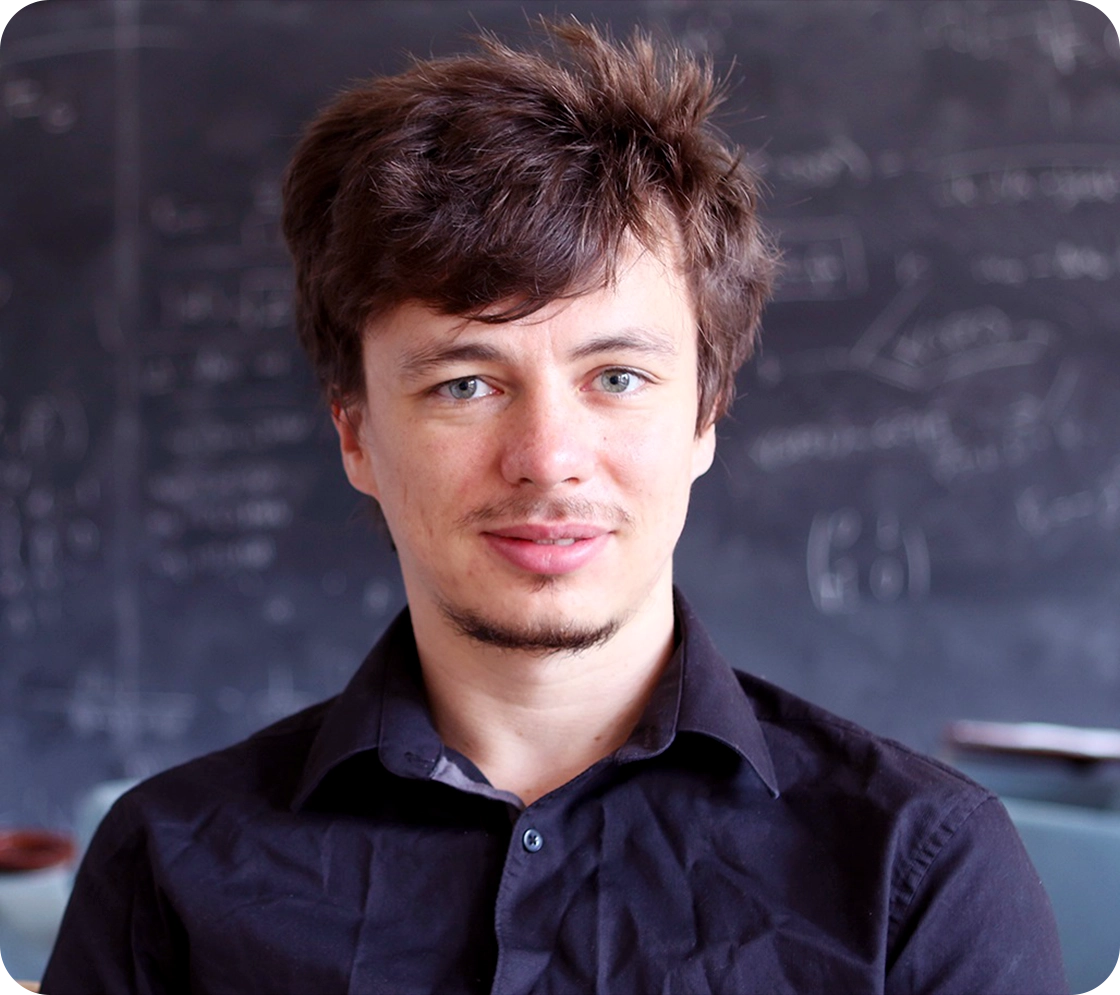
Geoff Penington studies holography at the University of California, Berkeley. He helped devise a new way to compare the entropy of two black holes.
Lee Sandberg, Institute for Advanced Study
But holography can’t yet tell physicists what they most want to know: What happens deep inside a black hole at the point known as a singularity, where Einstein’s equations fail and the smooth space-time fabric breaks down? What strange occurrences would an astronaut — or a sensor — observe as they approached this singularity? Theorists know how to tap out the boundary ripples for a measurement outside a black hole, but they still don’t know the rhythm corresponding to sending a probe into the hole and retrieving its reading. These are esoteric questions today, but many holographers aspire to someday program such ripples into future quantum computers and simulate the breakdown of Einstein’s space-time fabric.
“If you want to simulate a black hole on a quantum computer in 60 years, what question are you going to ask?” said Jonathan Sorce, a physicist at the Massachusetts Institute of Technology. “I can’t even tell you what calculation to do.”
To find out, physicists have been trying to figure out what that genius von Neumann was up to nearly a century ago.

Perfect Space-Time, Infinite Entanglement
In 2020, Hong Liu, a physicist at MIT, was puzzling over just this problem. The blind spot deep inside a black hole tortured him. He specifically wondered what set of boundary ripples would simulate the flow of time inside a black hole — the ticking of a clock on board a spaceship that had flown in.
“This time is very mysterious,” Liu told me on a visit to his office, where a leaning tower of yellow legal pads on his desk threatened to undergo a pedestrian form of gravitational collapse. “How can you use this boundary to describe time going inside the [black hole] horizon?”
To investigate, Liu and his student Sam Leutheusser conjured up a black hole in the purest space-time they could imagine. In holography, the more rippling fields there are on the boundary, the more closely the bulk resembles Einstein’s fabric — smooth and continuous. Real space-time (like everything else in nature) should experience quantum fluctuations, which blur the notions of “here” and “there.” Understanding smooth, idealized space-time first can serve as a sort of warmup problem to understanding the real, quantum mechanically fluctuating fabric described by a quantum theory of gravity.
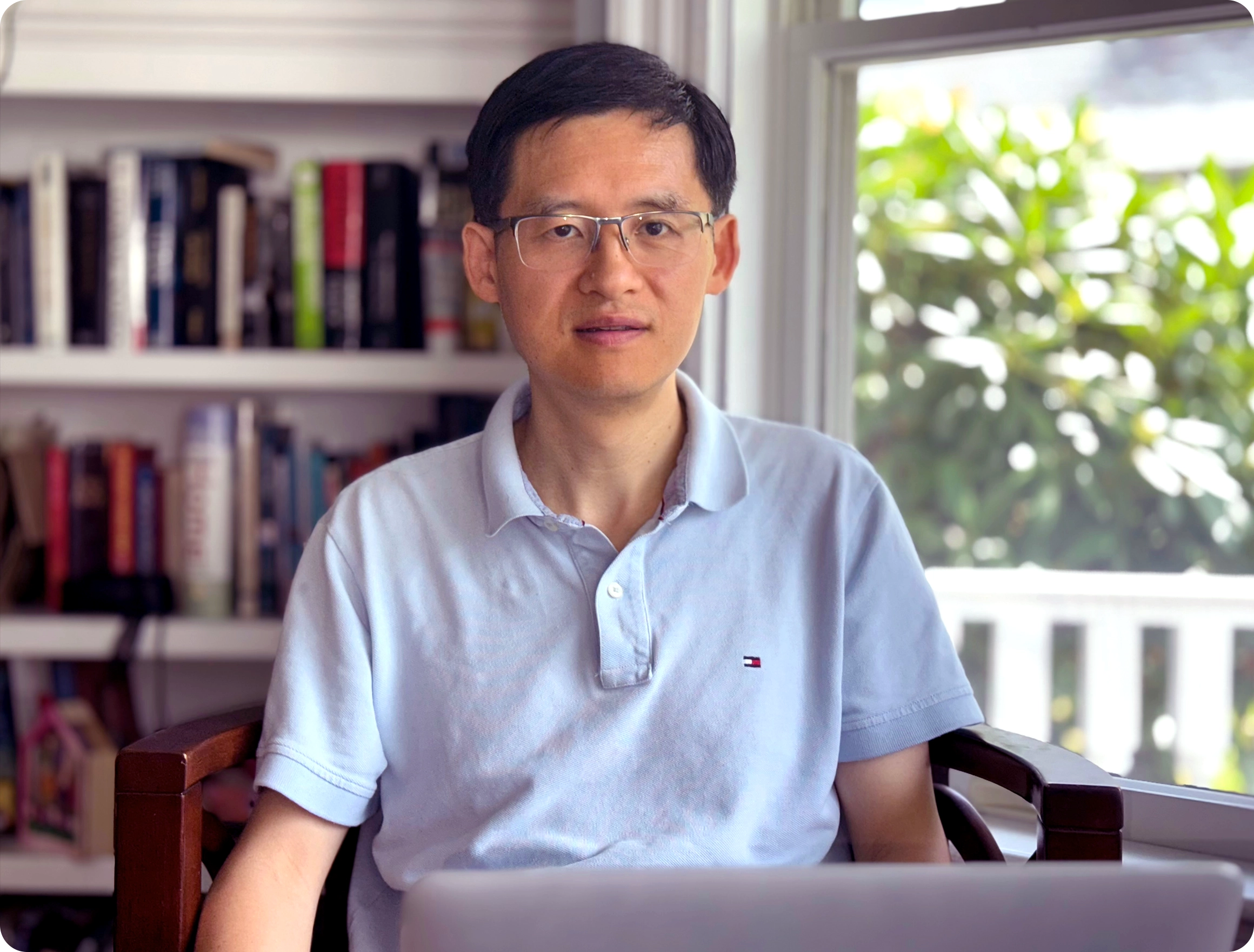
Hong Liu, a professor at the Massachusetts Institute of Technology, recently argued that a smooth space-time must be described by a particular type of algebra.
Hong Liu
Liu and Leutheusser wondered exactly what would change as the boundary fields became infinitely numerous — corresponding to the dying gasp of the last quantum fluctuation of the bulk space-time. “What kind of mathematical and physical structure is needed for the emergence of all this space-time?” Liu asked.
But more fields meant more problems. The ripples (that is, the particles) in these fields can come to depend on one another through an intrinsically quantum relationship known as entanglement. When two particles are strongly entangled, measuring their orientations will reveal them to always point in opposite directions. Similarly, how a field ripples at a certain point can depend on a faraway ripple in some other field.
Since Liu and Leutheusser wanted to describe a perfectly smooth black hole in a flawless space-time, they needed to have an infinite number of quantum fields on the boundary. But this created problems. Any region of the boundary would have an infinite amount of entanglement, since the quantum ripples in that patch would be entangled with the infinitude of ripples outside it. Because of this, familiar holographic tools became useless. To understand the transition from fluctuating to smooth space-time, the duo needed to get a handle on this new infinity.
“You want to really find some kind of intrinsic way to describe this infinite amount of entanglement,” Liu said. “Surprisingly, it turns out some work of von Neumann from the early 1930s is the perfect tool for this.”

The Importance of Uncertainty
By 1932, the 29-year-old von Neumann had reinvented the mathematical language of the nascent quantum mechanics. The verbs that glued his new grammar together were physical actions — measuring a particle’s position, say, or moving it, or flipping it upside down. By listing these operations and the rules for combining them to make new operations, one could capture every physical facet of any quantum system, from a hydrogen atom to a solar system.
These lists are known as operator algebras. They amount to a detailed accounting of everything that could happen inside a given region, when you know nothing about the rest of the universe outside it.
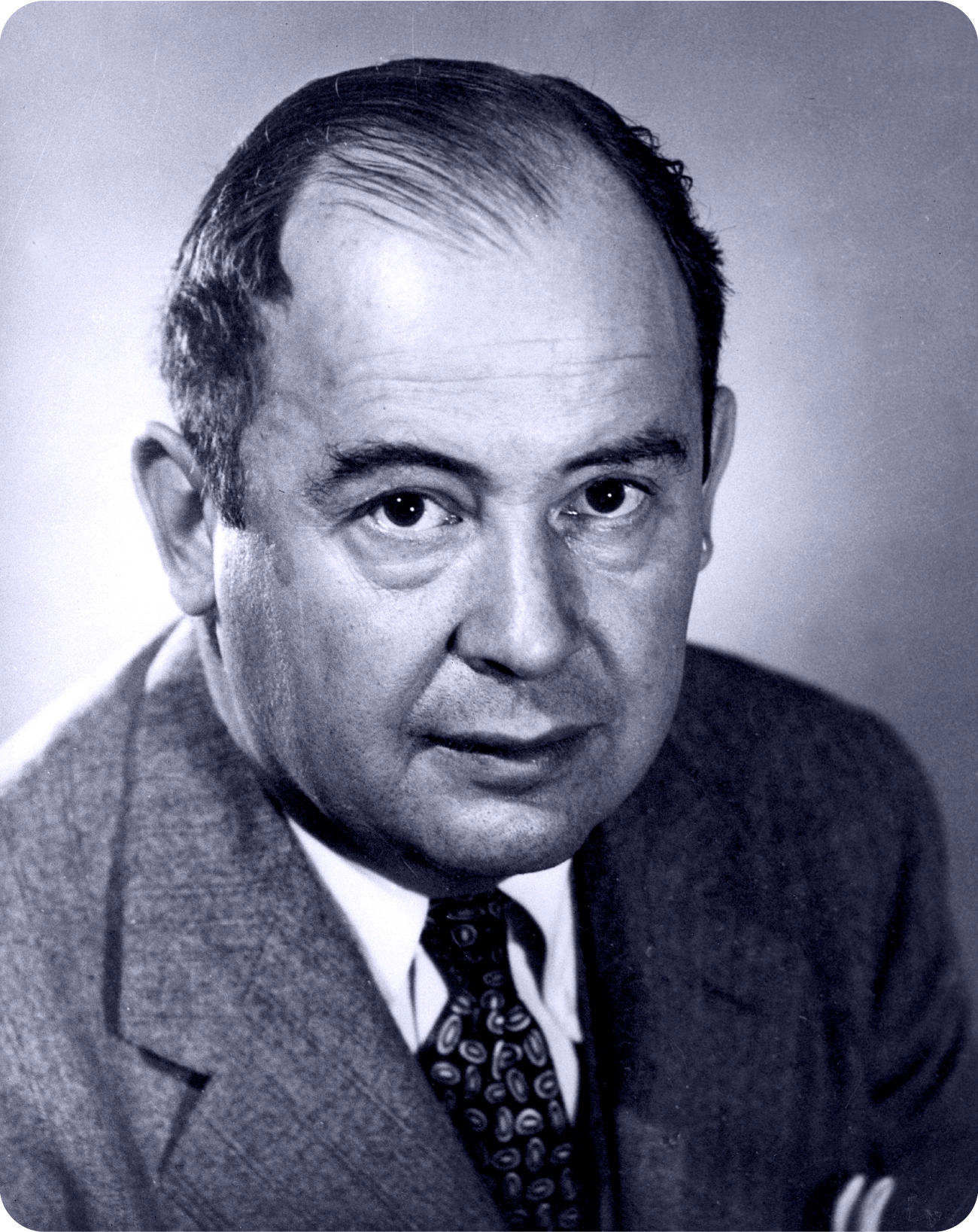
John von Neumann, who was born in Hungary in 1903, launched or revolutionized multiple fields including quantum mechanics, game theory, computer science and information theory. He developed a universal language for all quantum systems that’s now being applied to the quantum features of space-time.
Alan W. Richards, Emilio Segre Visual Archives
Von Neumann and a collaborator, Francis Murray, eventually identified three types of operator algebras. Each one applies to a different kind of physical system. The systems are classified by two physical quantities: entanglement and a property called entropy.
Physicists first discovered entropy while studying steam engines in the 1800s. They later came to understand it as a measure of uncertainty. You might know the temperature of a gas, for instance, but you’ll remain uncertain of the specific locations of all its molecules. Entropy counts how many possible states of the molecules’ positions and trajectories there could be. Similarly, in quantum systems, entropy is also a measure of your ignorance. It tells you how much information you can’t access because of the entanglement between your quantum system and the world outside.
![Pullquote that reads "[The new work] could be seen as an argument that any theory of quantum gravity should be holographic.” – Geoff Penington, University of California, Berkeley](https://www.quantamagazine.org/wp-content/uploads/2024/09/PQ_Holography-01-1.png)
Von Neumann algebras specify what kind of entanglement a system has, and accordingly, how well you can come to know it.
Type I algebras are the simplest. They describe systems with a finite number of parts, which can be completely disentangled from the rest of the universe. So if the parts of the system do become entangled with the outside, you can tell precisely how much they have done so. Their entropy — your ignorance — is limited. You can always calculate exactly what it is. Sorce likens such algebras to a beaker with the water level representing the entropy. You can see the bottom, so you know the height of the water.
Type II algebras are trickier. They describe systems that have an infinite number of parts, all inextricably entangled with the outside. Absolute entropy is infinite — and therefore meaningless. But the system has some uniformity that gives you a reference point. The parts might all be as entangled with the outside as they can possibly be, for instance. Then, if you disentangle five particles, you know that entanglement has decreased by five units. The absolute amount of uncertainty is unknowable, but you’re a little less uncertain than before; five units less, to be precise. You can’t see the beaker’s bottom, but you can see when the water level rises or falls.
The final type, type III, is the worst: It describes a system with infinite parts, infinite entanglement with the outside, and no uniform pattern in the entanglement to help you get oriented. Not even changes in entropy are knowable. The beaker’s bottom is too distant to see, and so is the water level above you.
“Type III is flipping horrible, and no one wants to deal with them,” Penington said (using stronger language than “flipping”).
![Pullquote that reads "[The AdS-CFT correspondence] is saying that gravity is just a different description of quantum theory." - Josephine Suh, Korea Advanced Institute of Science and Technnology](https://www.quantamagazine.org/wp-content/uploads/2024/09/PQ_Holography-02-1.png)
When von Neumann and Murray first encountered type III algebras, they found them too alien to understand. The nature of these algebras would remain mysterious for more than three decades until Alain Connes, a French mathematician, managed to define them in 1973. The feat won Connes the Fields Medal, math’s highest honor. He determined that what set type III algebras apart was related to a fearsomely technical property called modular flow.
Very roughly speaking, modular flow resembles the flow of time — but it’s more abstract. It’s a physical process that takes a system at a particular temperature and keeps it at that temperature. A room-temperature cup of tea naturally experiences modular flow (and normal physical time) because it stays at room temperature. But for a steaming-hot cup of tea, modular flow is the sequence of operations needed to keep it eternally hot. That’s not something that would ever happen naturally, since it requires constantly fiddling with all the tea’s atoms, but it’s a process that can be specified mathematically. Connes realized that a type III algebra describes a system so entangled with its surroundings that the system’s modular flow also becomes inseparable from what’s going on outside.
Mathematicians — and a few intrepid physicists — would continue to study von Neumann algebras and their modular flows. But only in the last few years have quantum gravity researchers come to appreciate their power.

Alien Algebra
When Liu and Leutheusser were trying to understand what happens inside a black hole, they situated it in a perfectly smooth bulk space-time. They knew that fluctuating, quantum space-time corresponded to a finite number of entangled fields on the boundary and a type I theory. But as they added fields to the boundary to ensure that space-time became smooth, they saw that the algebra changed from type I to type III. In other words, the more fields there were, and the more entanglement, the closer space-time behaved to its idealized, classical version.
They then used the hopelessly entangled modular flow of the type III algebra to sneak a peek inside the black hole lurking in their bulk. Starting with a simple pattern of boundary ripples that they knew simulated a measurement device outside the black hole, they argued that a certain procedure involving a type III modular flow would bring the device inside the hole, where it could measure the flow of time. This process achieved Liu’s goal of determining what intricate pattern of boundary ripples was equivalent to a ticking clock inside a holographic black hole.
“These new structures give you emergent time,” Liu said.
They weren’t the only physicists rediscovering von Neumann algebras. Other groups were also using modular flow to understand black holes. A 2017 proposal, for instance, took a measurement device inside a black hole and scrambled it in such a way that it ended up outside. And in 2020 researchers imagined firing a small black hole into a larger one and using the little black hole’s modular flow to get it back out.
Sorce, who worked on another modular flow procedure this spring, says these algorithms are all pushing toward a single goal: understanding how quantum particles would behave near a singularity. The singularity would live in AdS space rather than in a realistic universe, but most holographers expect that all space-time fabrics should fray in similar ways. (Physicists outside the holography community question that assumption.) “If you could understand singularities in AdS space at the quantum level, you would be very happy in declaring victory in understanding them in our universe,” Sorce said.
Liu and Leutheusser put a spotlight on what had been something of a backwater of mathematical physics. “Before Hong’s paper,” said Elliott Gesteau, a mathematical physicist at the California Institute of Technology, “it was kind of like a dream. There was a hunch that this must be important, but it wasn’t clear how to make this intuition precise.”
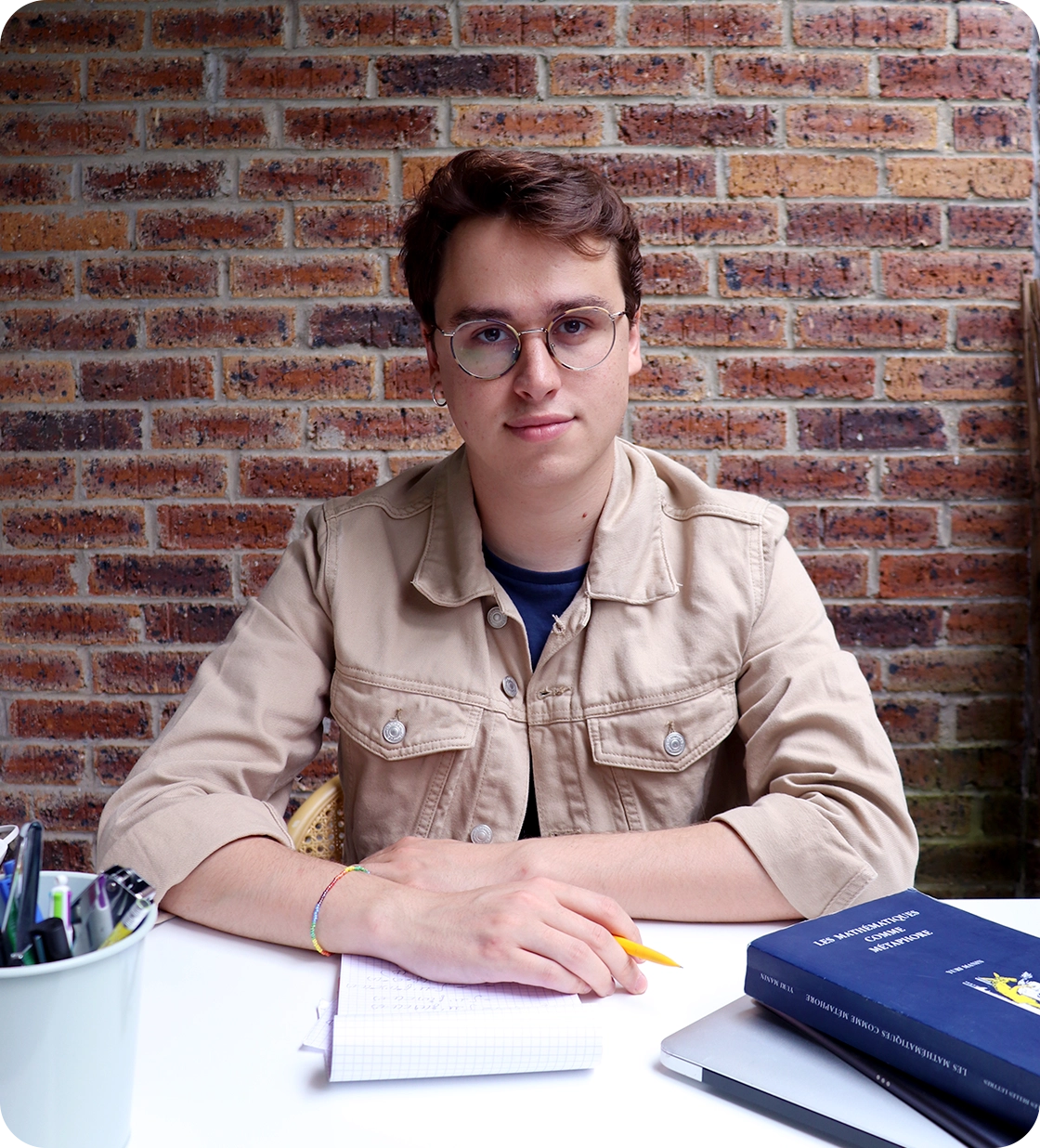
Inspired by an old suspicion that certain algebraic structures could be related to the flow of time, Elliot Gesteau, a physicist at the California Institute of Technology, recently teamed up with Hong Liu to develop the idea.
Elliott Gesteau
But perhaps a more significant turning point came when a 2022 paper used Liu and Leutheusser’s algebraic perspective to take a modest step away from AdS/CFT and toward our boundary-free universe. Its author was Edward Witten, perhaps the most revered theoretical physicist alive, and the only one to ever win the Fields Medal.
“That’s when I got very interested,” Penington said.

Holography Unbound
Witten made an unexpected discovery. He started with Liu and Leutheusser’s holographic black hole — an idealized model of smooth space-time, with no tremors and no quantum gravity. He then tweaked the boundary fields to allow extremely mild quantum quivers to creep into the bulk space-time. The change dissolved the type III algebra Liu and Leutheusser had seen into a type II algebra, making it possible to calculate changes in entropy (although not entropy itself — the level of the water came into view, but not the bottom of the beaker). “It completely changed the algebra,” Speranza said. “It was like a phase transition.”
Researchers noticed that Witten’s discovery didn’t rely heavily on the AdS/CFT context; the type II algebra seemed like a feature of any black hole experiencing mild tremors from the presence of matter. So Penington reached out to Witten, and together with Venkatesa Chandrasekaran they set out to move his calculation out of the AdS setting.
Their work suggests that a lightly quantum theory of a black hole in any kind of space-time has a type II algebra. Using that type of algebra to calculate how much the entropy of a black hole changes as matter falls into it, they found that the entropy goes up by a fixed amount, exactly as you’d expect if the black hole emerged from rearrangeable parts, analogous to a gas.
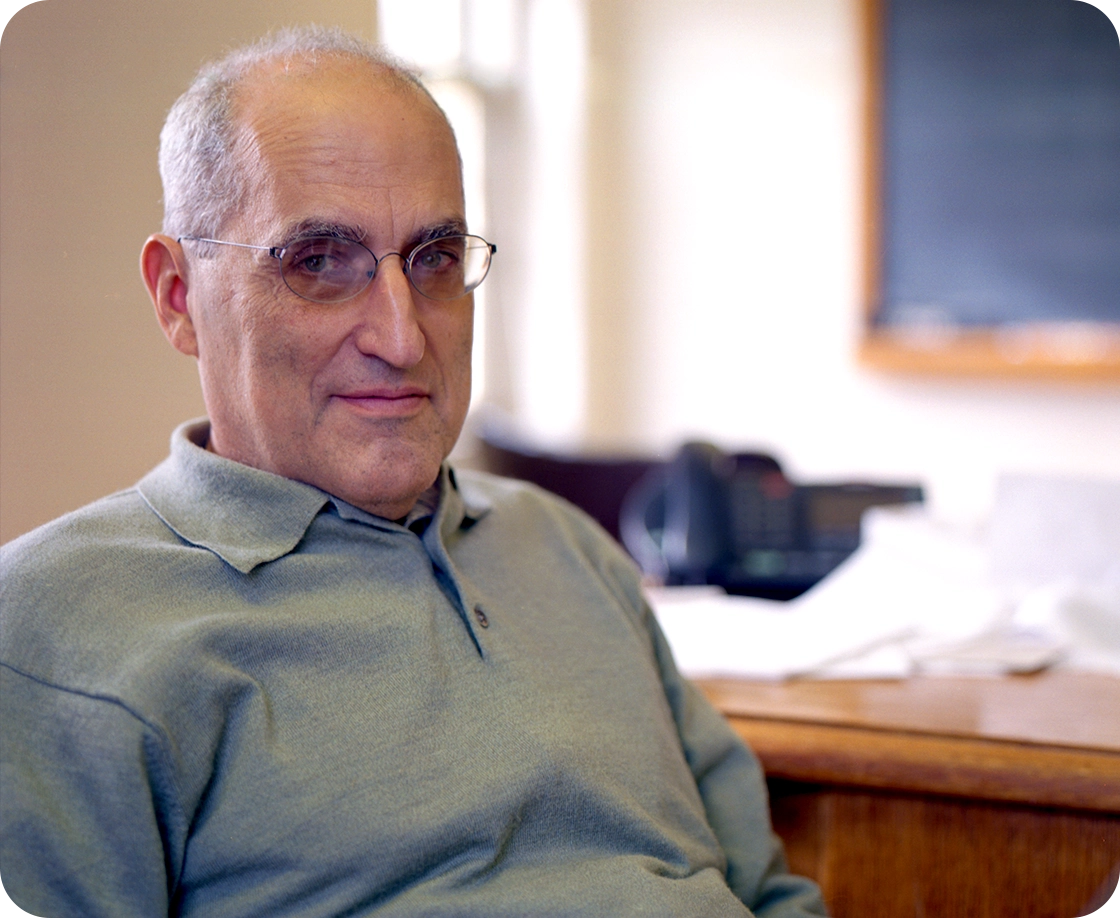
Edward Witten, a physicist at the Institute for Advanced Study, recently showed that mild quantum fluctuations of space-time can transform its algebra, making it easier to understand.
JeanSweep for Quanta Magazine
Sorce calls this finding “revolutionary” in that it echoes a crucial step in the prehistory of quantum mechanics. In the mid-1800s, physicists discovered a mysterious entropy that related to the efficiency of steam engines, but they weren’t sure what it meant. Then, toward the end of the century, Josiah Gibbs and Ludwig Boltzmann worked out how to calculate how entropy grows — as a gas expands, for instance — bolstering their suspicion that gases should be made of something like atoms. That work set the stage for quantum mechanics to explain the entropy of a gas in terms of its atoms in the 1900s.
For black holes, an analogous history dates back to the 1970s, when Jacob Bekenstein and Stephen Hawking took the first step of discovering that these entities have entropy. Physicists have taken this to mean that the contorted space-time fabric of a black hole may be made of atomlike parts, just like a gas. Now Witten and collaborators have done for black holes what Gibbs and Boltzmann did for gases: figured how to compare the entropies of two different states of a black hole. It’s a more concrete hint that their entropies do indeed reflect their microscopic parts.
The algebraic black hole calculation more rigorously reinforces another message from Hawking and Bekenstein’s work: Entropy increases in proportion to the black hole’s growing surface area. This finding indicates that a 3D black hole can be described in terms of atomlike parts arrayed on its 2D spherical surface. It’s one of the original clues that sent physicists down the road to holography long before the work of Maldacena, now rediscovered purely from the algebra of flat space-time with mild quantum fluctuations.
“It could be seen as an argument that any theory of quantum gravity should be holographic,” Penington said.

Zooming In and Out
Both the researchers hacking their way into black holes and those calculating the entropy from outside are using von Neumann algebras to tiptoe toward the ultimate goal: a theory of any space-time that can handle mild and violent quantum gravitational effects alike. Such a theory would reveal exactly what happens near singularities as space-time grows too threadbare to steer particles in the usual way.
The traditional approach to understanding space-time and gravity has been to posit the nature of reality at tiny scales — particles? quantum waves? strings of energy? — and zoom out to see if it matches our world. Holographers attempt to invert this approach: They start with the space-time fabric they know exists and try to zoom in as far as they can.
Von Neumann’s work, which mapped out what Sorce calls the “universe of allowed mathematics” for quantum theories, is guiding researchers as they tease apart Einstein’s fabric and see what sorts of quantum threads it could be consistent with. The findings continue a long-running trend that the threads look holographic; they can be described in 2D or in 3D. Now researchers are eager to learn more.
“I feel like the door is wide open for us to explore,” Liu said. “I find these algebraic ways to be very powerful.”
On the way out of Maldacena’s office at the Institute for Advanced Study, I asked if studying holographic space-time had changed how he sees the world as he goes about his daily life. Laughing, he said that when he walks around the campus, he sometimes wonders if he might really be moving from one patch of entangled quantum fields to another.
As I walked back to the Princeton train station, I tried — rather unsuccessfully — to visualize how the nothingness of space could emerge, hologram-style, from quantum ripples. I noticed on Google Maps that a short detour would take me by a local landmark, the house Einstein lived in after he moved to the institute in 1933, soon after von Neumann arrived. Einstein would spend the next two decades searching for a theory that would unify his description of space-time with quantum forces, right up until the day he died in 1955.
He did not succeed. And he probably had no inkling that his life’s quest was in any way connected to the algebras of his colleague von Neumann, who departed our space-time two years after Einstein, aged 53. Given the convoluted lengths physicists have gone to as they struggle to connect the work of both geniuses, perhaps that’s no surprise. If the secrets of space-time really are buried within the ripples of highly entangled quantum fields, they are deeply, deeply hidden.
